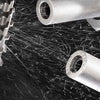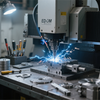
The Science of Grit Size in Sand Blasting: Precision Surface Engineering
Why Grit Size Dictates Your Surface Finish
Grit size in abrasive blasting isn't just a number—it’s the primary lever controlling surface texture, fatigue resistance, and coating adhesion. Smaller grits (e.g., #220) deliver fine finishes but remove material slowly, while coarser grits (e.g., #60) aggressively shape edges yet risk dimensional inaccuracy. The physics is clear: finer particles increase surface contact points per square inch, enabling uniform peening and residual stress control. However, excessively fine grits (≤50µm) can cause agglomeration, leading to inconsistent impact energy distribution.

Aluminum 6061 vs 7075: The Definitive Guide to Choosing Your Alloy
Introduction: The Critical Crossroads
In precision engineering, selecting the right aluminum alloy can mean the difference between optimal performance and catastrophic failure. 6061 and 7075 – two of the most widely used alloys – sit at opposite ends of the aluminum spectrum. While 6061 offers versatility and economy, 7075 delivers aerospace-grade strength. Yet misapplying either can lead to costly redesigns, premature failures, or bloated budgets.

Demystifying Surface Roughness Value: The Key to Functional Precision
Why Surface Roughness Matters
Surface roughness quantifies microscopic peaks and valleys on machined parts. It directly impacts:
-
Functional Performance: Friction, wear, sealing, lubrication retention
-
Aesthetics: Visual appearance and light reflection
-
Manufacturing Cost: Finer finishes require additional operations (grinding, polishing)

CNC Machining Cost Optimization Without Sacrificing Quality
Why CNC Machining Costs Add Up Quickly
CNC machining is renowned for its precision, consistency, and flexibility, but these advantages come at a price. The primary cost drivers include machining time (the largest expense, often exceeding material or setup costs), material expenses, setup and CAM, and specialized tooling or tolerances. Complex geometries, deep cavities, thin walls, or non-standard features exponentially increase production time and resource use. For instance, machining a deep pocket might require incremental tool passes with specialized cutters, while strict tolerances demand slower speeds, advanced equipment, and rigorous inspections

The Three Types of EDM Machining and Their Critical Differences
Electrical Discharge Machining (EDM) enables precision machining of conductive materials regardless of hardness. Three distinct technologies dominate industrial applications:
-
Sinker EDM: Uses custom-shaped electrodes to create 3D cavities (±0.01mm accuracy; ideal for mold cores and turbine blades)
-
Wire EDM: Employs continuously moving wire for 2D/tapered cuts (±0.001mm precision; optimal for tooling and medical instruments)
-
Micro EDM: Utilizes rotating micro-electrodes (Ø0.03–0.3mm) for features down to 5μm (critical for fuel injectors and medical implants)
Key differentiators include electrode configuration, dimensional capabilities, and surface finish requirements (Ra 0.05–0.2μm).

How is CNC Machining Cost Determined?
CNC machining costs are primarily driven by material selection (40-60%), machine time (amplified by 5-axis complexity), and geometric tolerances (±0.025mm can increase costs 150%). Hidden expenses include tool wear (e.g., $0.38/min for titanium) and post-processing. To optimize:
-
Partner with factory demonstrating ISO-certified 5-axis precision (±5μm)
-
Demand operation-level cost breakdowns
-
Prioritize vendors offering scientific DFM feedback within 24h
True cost efficiency comes from technical collaboration, not price negotiation – strategic partnerships reduce TCO by 18-32% through process innovation.

CNC Machining in Rapid Prototyping: Integrated Workflow from Digital Design to Precision Machining
Core Value: Enables deterministic transformation of CAD data into dimensionally compliant prototypes, accelerating product validation cycles across automotive, aerospace, medical, and consumer electronics sectors.





